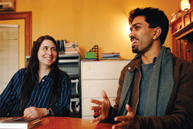Poverty: An insidious social sickness
Poverty: An insidious social sickness McGill University
User Tools (skip):
Poverty: An insidious social sickness
McGill researchers turn studies into social action
For a social condition that is so prevalent, poverty is surprisingly slippery to define. Some governments draw a neat line in the sand and anyone whose annual income falls below an agreed amount is officially designated poor. Others evaluate poverty using relative measures, for example, calling poor those individuals and families earning less than half the median national income. Unfortunately, unlike the freezing point of water, the definition of poverty is not absolute.

With the recent election of the Conservatives, Jody Heymann (seen here with Baijayanta Mukhopadhyay) sees the country at a critical crossroads when it comes to childcare. Early education has a big impact on a person's long-term working income, she says.
Owen Egan
For Jody Heymann, holder of a Canada Research Chair and director of McGill's six-month-old Institute for Health and Social Policy (IHSP), classifying poverty is a double-edged sword. While researchers need a concrete definition in order to track trends and measure the failures and successes of social assistance programs, the target is always moving. When discussing the fundamental flaw of poverty lines, Heymann shakes her head. "It's easy for a country to get rid of poverty," she says. "Just draw the line lower."
Not surprisingly, for a researcher who has dedicated much of her professional life to studying the situation of the poor worldwide, Heymann seems more concerned about alleviating the condition than defining it. And, as she sees it, there are three ways for people to overcome poverty. "You can win the lottery. You can marry a billionaire. But 99 percent of people get out through work."
Having just published her groundbreaking book, Forgotten Families, Heymann is well-placed to offer her expertise on the subject of work and poverty. Based on more than 1,000 in-depth interviews and survey data from more than 55,000 families, the book is the first global account of the impact that changing work conditions have on families worldwide.
Although Heymann's research for Forgotten Families doesn't include Canadian data (she did the bulk of her work while at Harvard), she is confident that the findings are applicable just about anywhere. "There are lessons to be learned from other countries," she says - and sometimes those lessons are surprising.
For example, she found that when it comes to caring for sick children, families in Ho Chi Minh City in Vietnam and San Cristobel de las Casas in Mexico were far better off than those in Baltimore, U.S.A. While Vietnam and Mexico both have progressive social policies that give paid parental sick leave, the state of Maryland does not. As a result, parents of a sick child in Baltimore are put under an inordinate amount of financial stress along with the emotional stress that comes with illness.
How does this relate to poverty? Heymann cites a longitudinal study that tracked families over 15 years. "In jurisdictions that had no sick leave legislation," she says, "a chronically ill child was one of the biggest predictors of a parent losing their job." Now, thanks in large part to Heymann's work with American lawmakers, some 26 states are working toward sick leave legislation.
The IHSP will take much of the data gleaned from around the world and apply it to local issues. "Simply put, working conditions in Quebec and Canada are directly affected by the global economy," says Heymann. "We must understand what is happening worldwide in order to tackle local issues."
Rag trade exploits non-status workers
A case in point can be found within Montreal's textile industry. Notoriously hard on its workers and a traditional employer of undocumented labourers (most recently from South Asian countries), the industry has become an ironic casualty of global competition.
As unregulated sweatshops in foreign countries force the price of labour to rock bottom levels, unethical owners of local businesses have had to come up with novel ways to further exploit their illegal workforce; outsourcing jobs to non-status people working from their homes. Seamstresses toil for 10 to 12 hours a day alone, away from what little protection they might find in a work environment surrounded by peers.
Because their legal status makes them so vulnerable, home workers are easy prey for businesses looking to gain a competitive edge. "Not only are they paid significantly less than minimum wage, they are also unable to create meaningful social bonds at a critical juncture in their life," says Baijayanta Mukhopadhyay (MA Sociology), who is involved with a small Montreal organization seeking to help these undocumented home workers. "You need to find ways to integrate and interact with others, especially if you're a newcomer to the country. You can't do this sitting at home all alone."
Mukhopadhyay has enlisted the help of the IHSP, hoping to benefit from Heymann's expertise as a researcher and as a person who can translate that research into policies and programs. With support from the IHSP, he wants to compile data on the number of home workers out there, their working conditions and what companies are using them - a time-consuming process. "Most of these people are very reluctant to speak up," says Mukhopadhyay. "The key is to develop a relationship of trust. If I could clear everything off my plate and spend the next four months at this, I could build those relationships and collect a lot of useful data. From there, we could take steps to make meaningful changes."

